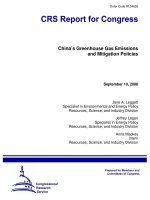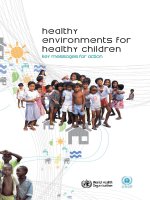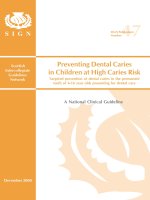Tài liệu Healthy environments for healthy children: key messages for action doc
Bạn đang xem bản rút gọn của tài liệu. Xem và tải ngay bản đầy đủ của tài liệu tại đây (4.19 MB, 76 trang )
Healthy environments for healthy children: key messages for action
WHO Library Cataloguing-in-Publication Data
Healthy environments for healthy children: key messages for action.
1.Environmental health. 2.Environmental exposure. 3.Potable water. 4.Sanitation. 5.Child
welfare. 6.Infant welfare. I.World Health Organization. II.United Nations Environment
Programme.
ISBN 978 92 4 159988 7 (WHO) (NLM classification: WA 30)
ISBN 978-92-807-2977-1 (UNEP)
© United Nations Environment Programme and World Health Organization 2010
All rights reserved. Publications of the World Health Organization can be obtained from WHO
Press, World Health Organization, 20 Avenue Appia, 1211 Geneva 27, Switzerland (tel.: +41
22 791 3264; fax: +41 22 791 4857; e-mail: ). Requests for permission
to reproduce or translate WHO publications – whether for sale or for noncommercial
distribution – should be addressed to WHO Press, at the above address (fax: +41 22 791
4806; e-mail: ).
The designations employed and the presentation of the material in this publication do
not imply the expression of any opinion whatsoever on the part of UNEP, UNICEF or WHO
concerning the legal status of any country, territory, city or area or of its authorities, or
concerning the delimitation of its frontiers or boundaries. Dotted lines on maps represent
approximate border lines for which there may not yet be full agreement.
The mention of specific companies or of certain manufacturers’ products does not imply
that they are endorsed or recommended by UNEP, UNICEF or WHO in preference to others
of a similar nature that are not mentioned. Errors and omissions excepted, the names of
proprietary products are distinguished by initial capital letters.
All reasonable precautions have been taken by UNEP, UNICEF or WHO to verify the
information contained in this publication. However, the published material is being
distributed without warranty of any kind, either expressed or implied. The responsibility
for the interpretation and use of the material lies with the reader. In no event shall UNEP,
UNICEF or WHO be liable for damages arising from its use.
Printed in France
UNEP promotes environmentally sound practices globally and in its own activities. This
publication is printed on chlorine free, acid free paper made of wood pulp from sustainably
managed forests. Our distribution policy aims to reduce UNEP’s carbon footprint.
Design & layout: L’IV Com Sàrl, Le Mont-sur-Lausanne, Switzerland
Chlorine-free paper
Recycled paper 100%
Ink from renewable resources (vegetable)
FSC and PEFC certified.
COUV DOS5MM:Mise en page 1 26/07/10 12:14 Page2
Contents
Healthy Environments for Healthy Children – Key Messages for Action 3
Introduction 5
Global Environmental Change 7
Climate Change 8
Deforestation 10
Biodiversity 12
Land Degradation and Desertifi cation 14
Water, Sanitation, and Hygiene 16
Water 17
Sanitation 19
Hygiene 21
Hazardous Waste 22
Nutrition, Growth and Development 23
Nutrition 24
Breastfeeding 26
Obesity 28
Vectors of Disease 30
Malaria 31
Dengue 33
Tick-borne Diseases 34
Air 35
Indoor Air Pollution 36
Outdoor Air Pollution 38
Ozone 40
Chemicals 41
Lead 42
Mercury 43
Pesticides 44
Persistent Organic Pollutants (POPs) 46
Household Products 47
Injuries 49
1
Environmental Emergencies 52
Noise 54
Healthy Housing 56
Tools and Mechanisms Available to Recognize, Prioritize,
Monitor and Promote Children’s Environmental Health 58
Environmental Burden of Disease Estimates 59
2009 Busan Pledge of Action on Children’s Health and Environment 64
References 68
Acknowledgements 70
2
Healthy Environments for Healthy Children
Healthy Environments for Healthy
Children —
key messages for action
T
his booklet presents key messages for action, summarized from a set of
chapters on different environmental health issues, available at www.who.int/
ceh/publications/healthyenvironmentsforhealthychildren. The work is a result
of an on-going partnership between WHO, UNEP and UNICEF in the area of children’s
environmental health, and seeks to update the 2002 joint publication “Children in
the New Millennium: Environmental Impact on Health.”
1
Over the last 20 years there have been acknowledgements at the highest level of the
need to protect the environment in order to underpin efforts to safeguard child health.
As far back as 1989, States pledged in the Convention on the Rights of the Child
2
to “combat disease and malnutrition… taking into consideration the dangers and
risks of environmental pollution.” Recently, the call for action to address children’s
environmental health (CEH) has been gaining momentum, as more is known about
how adverse environments can put children’s growth, development, well-being and
very survival, at risk. Notably, the G8 Siracusa Environment Ministerial Meeting,
3
(April, 2009) recently expressed “We can do more to ensure that children are born,
grow, develop and thrive in environments with clean air, clean water, safe food, and
minimal exposure to harmful chemicals.”
We have committed to this work faced with the knowledge that around three million
children under fi ve years die each year due to a number of largely preventable
environment-related causes,
4
and conscious of the fact that environmental challenges,
including climatic change and increased urbanisation, have the potential to make
every one of the United Nations Millennium Development Goals, including those on
eradicating poverty and improving the health and well-being of children and their
caregivers, less achievable. The poorest and most marginalized children in developing
countries suffer most. Although many commitments and international agreements
have been made in relation to protecting children’s health from environmental threats,
progress towards stemming these risks has been slow.
Signifi cant action is now required to achieve healthier, safer and cleaner environments
– as this is not only imperative for child health, but also possible. Tools and
mechanisms are available. Partnerships for acting together on many fronts, building
3
on existing programmes and adapting concrete actions to local needs, can make a
difference.
WHO, UNEP and UNICEF are jointly taking a step forward in this booklet, proposing
key messages for concrete action to confront the environmental health issues
faced by children, their parents and communities all over the world. The aim is to
provide decision makers at all levels (from the local to the international), including
community leaders, teachers, health-care providers, parents, and other caregivers,
with the information they need to promote healthier environments for children, using
practical examples. The challenge is to ensure that everyone knows and understands
the threats to child health and well-being from environmental risk factors and is
motivated to take practical action to minimize these risks.
The future of our children and their lives as adults depend on a full enjoyment of good
health in a safe, protective environment, from conception to adolescence and beyond.
4
Healthy Environments for Healthy Children
Introduction
G
lobally, children are disproportionately exposed to a myriad of environmental
threats. Evidence is mounting that worsening trends of global environmental
degradation, including the erosion of ecosystems, increased pollution, and the
effects of climatic changes, contribute to the burden of disease confronting children,
in both developed and developing countries. These circumstances are affecting the
world’s ability to meet the Millennium Development Goals (MDGs) and the other
internationally agreed upon development goals.
The health implications of environmental degradation for children are profound. Every
year, around three million children under fi ve die from preventable environment-
related causes and conditions. This makes the environment one of the most
critical contributors to the global toll of 8.8 million child deaths annually,
5
with the
noteworthy killers – if a child survives the neonatal period – being respiratory and
diarrhoeal diseases, and malaria. Air pollution, unsafe water, lead in soil, pesticide
residues in food, and ultra-violet radiation are a few of the multitude of environmental
threats that may alter the delicate organism of a growing child, causing disease,
developmental problems or adverse effects later in life.
Children are especially vulnerable, as they respond differently than adults when
exposed to environmental factors. Their immune defences are not fully mature and
their developing organs are more easily harmed; thus environmental contaminants may
affect children disproportionately. In addition, their airways are smaller than those of
adults, and irritating particles may act very fast, causing respiratory diffi culties. They
generally spend more time active and outdoors than adults, increasing their risk of
exposure considerably. Also proportionate to their size, children ingest more food,
drink more water and breathe more air than adults, and children’s normal activities –
such as putting their hands in their mouths or playing outdoors – can result in higher
exposures to certain contaminants. Even while in the womb, the child-to-be can also
be exposed to adverse environmental risk factors that may give rise to diseases later
in life – imposing a heavy burden on public health systems.
We still have an “unfi nished agenda” to control those diseases linked to unsafe water
and food, lack of sanitation and indoor air pollution. In addition, children may be
exposed to new or recently recognized risk factors: climate change, ozone depletion,
manufactured nano-particles and endocrine disrupting chemicals (EDCs) are among
the relatively new concerns. Harmful chemicals in soil and effl uent, originating from
waste, traffi c or other activities may be present in places where children spend time.
5
Some especially long-lasting contaminants (mercury and persistent organic pollutants
– POPs) are widely recognized as a threat to health and the environment and are the
focus of major international agreements.
Environmental threats and exposure are in many cases preventable. Pro-active
coordinated actions are required to raise awareness and reduce risk and vulnerability.
Preventive interventions on the environmental management and health sector sides
have proven to be effective in protecting children from adverse exposures in many
countries and provide a wealth of knowledge and experience from which we can build
a strong foundation for informed and effective action.
Drawing on these experiences, as well as advances in the research and data
available, we present in this booklet key messages for action in relation to the main
environmental threats to children.
6
Healthy Environments for Healthy Children
Actions to tackle global environmental
change can be taken at all levels from
the international, to the national,
community, school and individual,
and can bring about immediate
benefi ts to child health.
Global Environmental
Change —
CLIMATE CHANGE, by altering weather patterns and
disturbing life-supporting natural systems, affects the basic requirements for health
and well-being: clean air and sufficient water, sufficient food, functioning ecosystems
and adequate shelter. There is growing evidence that climate change is contributing
to the burden of disease, particularly in developing countries
6
, where health-care
systems are under-equipped to deal with the compounding effects of these changes.
Sustained and immediate climate change mitigation and adaptation measures
are essential for the protection of children, as many of their main killers (malaria,
diarrhoea and undernutrition) are highly sensitive to climatic conditions.
1 Climate change is likely to increase
the frequency and intensity of natural
disasters. Communities need to be
informed about risks and vulnerabilities,
and supported to develop preparedness
and response strategies, with a focus
on the vulnerability of children and
teaching them how to respond.
2 Climate change threatens water supplies
and quality. Communities need to be
supported in managing water resources
in an integrated way, protecting existing
sources and the ecosystems that
support them, and sustainably utilizing
safe alternative sources (i.e. rainwater
harvesting).
3 Weather disruptions, exacerbated
by climate change, including rises
in temperature and shifts in rainfall
patterns, will impact food supplies,
threatening nutrition and health. Water
stress and scarcity will increasingly
impact community water supply.
Communities should be supported in
terms of adjusting agricultural practices
to avoid losing crops to drought or
floods, i.e. where available, using more
drought resistant crop varieties, better
suited to the changed climate.
4 Climate change can make vector-borne
diseases, such as malaria, which are
highly sensitive to temperature and
rainfall, more widespread. Communities
should use insecticide-treated nets. They
should, if applicable, allow sprayers to
come into their homes to apply residual
insecticide on walls, and stop mosquitoes
from breeding by eliminating stagnant
water areas, and improving sanitation.
Key messages: what every family
and community should know about
climate change
8
Healthy Environments for Healthy Children
5 Climate change will undermine
air quality, compounding risks of
respiratory diseases. Solar cookers and
lamps, smokeless stoves and clean
energy alternatives are becoming more
affordable and should be promoted for
households. Decreased fossil fuel use
has positive effects on child health.
fo
hi
s on
hea
9
DEFORESTATION. Forests play a critical role in regulating
the world’s climate and supporting agricultural production, fi ltering and maintaining
water supplies, protecting against soil erosion, and preventing natural disasters.
Millions of people – including children – depend on forest products and services
for food, medicine, building materials, fuel for cooking and heating, and to support
livelihoods. Deforestation is affecting the availability and production of food, access
to clean water, exposure to disease, vulnerability to disasters, and respiratory health,
and thereby children’s health. The rich medicinal resources stored in forests are
another link to child health.
1 Deforestation affects the availability and
production of food directly through the
availability of forest foods and indirectly
through the impact on land with serious
implications for child nutrition.
2 Deforestation impacts watersheds,
compromises aquifer levels and rainfall
patterns, and intensifi es fl ooding and
droughts, threatening water supplies
that are vital for child health. By
preserving and managing forests,
communities are protecting valuable
water sources.
3 Deforestation leads to soil erosion and
land degradation, which can lead to
desertifi cation, mudslides or fl oods, all
with signifi cant implications for child
health and well-being. Communities
can protect their land and improve its
productivity by planting trees, especially
indigenous types.
4 Deforestation and subsequent land-use
changes can increase vector breeding
grounds, making diseases such as
malaria more widespread. Families and
communities can prevent such diseases
by preserving the forests and taking
action to stop mosquitoes and other
vectors from breeding.
Key messages: what every family
and community should know about
deforestation
“Children are more likely to
succumb to natural disasters.
They are born into this climate
change problem – trees being
cut, rubbish being burned. These
are serious issues affecting a
child’s health and future.”
Honorable Maria Mutagamba
Minister of Water and Environment Republic
of Uganda
10
Healthy Environments for Healthy Children
5 Deforestation contributes to climate
change, which in turn impacts child
health. By preserving the forests,
communities are both mitigating and
adapting to climatic changes.
6 Deforestation impacts respiratory health
– with indoor air pollution from fuel-
wood use and outdoor air pollution from
fires set to clear land. Communities
should be supported in shifting to
cleaner, more sustainable sources of
energy, and in using traditional energy
sources more efficiently.
11
BIODIVERSITY. Child health is highly dependent on the
maintenance of functioning ecosystems that can provide clean water and air, food
and medicine. The loss of ecosystem productivity, such as decreased soil fertility or
over-fishing, can lead to malnutrition, stunted growth and development, and increased
vulnerability to disease. Biodiversity loss and ecosystem degradation also compromise
the resilience of communities in the face of natural disasters, altering exposure and
vulnerability to disease outbreaks, and increasing the risks faced by children living
in harsh environmental conditions.
1 Biodiversity plays a crucial role in child
nutrition, enabling the production of
foods, both wild and cultivated. Actions
to conserve biodiversity and promote
ecosystem management help improve
food security and child nutrition, by
providing a stable environmental basis
for sustained food production. Support
should be given to communities to
cultivate a variety of traditional foods
(including in school gardens), to plant
and care for indigenous trees, and to
organize awareness campaigns.
2 Biodiversity loss compromises the
ability of ecosystems to provide and
purify water. Ecosystems, particularly
wetlands, act as sponges that filter
impurities from rainfall and runoff.
Children, in particular, need clean
water to survive.
12
Communities need
to be enabled to protect and manage
ecosystems in an integrated way,
including protecting watersheds to
support water supply and quality.
3 Biodiversity provides a unique and
irreplaceable source for medicines and
advances in understanding disease,
thereby supporting child health. For
many centuries, plants have been used
to make medicines, and more recently,
soil microbes have provided the source
for antibiotics. New advances are
being made all the time, reaping as
yet unknown and innumerable benefits
biodiversity. Communities and youth
groups should be enabled to conserve
and benefit from their local biodiversity,
including learning from traditional
practices and focusing on plants that
have medicinal value.
Key messages: what every family
and community should know about
biodiversity
12
Healthy Environments for Healthy Children
4 Biodiversity is essential to reduce the
vulnerability of communities. The loss
of biodiversity destabilizes ecosystems,
weakening their resilience and ability to
deal with the frequency and impact of
natural disasters. Communities should
be enabled to preserve key ecosystems,
such as mangrove forests and coral
reefs which are natural buffers against
fl oods and storms.
fo
ra
e na
uffe
s.
13
LAND DEGRADATION AND
DESERTIFICATION. The consequences of land degradation
and desertification include malnutrition and famine, and the increase of waterborne,
infectious and respiratory diseases. They have massive socio-economic effects
including destroying livelihoods and deepening poverty. Studies show that the average
infant mortality rate (about 46 per 1,000) in developing nations newly affected by
desertification, the so-called “drylands”, exceeds that for non-”dryland” countries
by one fifth or more.
7
1 Land degradation and desertification
undermine ecosystem services,
including soil productivity, with
consequences for food production and
child nutrition. Practical measures to
prevent and restore degraded land,
include a range of sustainable land,
water, forest and livestock management
practices. Planting trees in degraded
land – and among crops – can have
many benefits – including restoring soil
productivity, preventing soil erosion and
sequestering carbon.
2 The scarcity of water in drylands
reduces access to clean drinking
water, adequate sanitation and water
for food production and survival, with
direct impact on children. The loss
of water sources forces people to use
polluted water. In addition, traditional
water-fetchers, namely mothers and
children, must walk further to fetch
water, often alone – increasing their
caloric and water need – and putting
them at risk of physical and sexual
assault.
8
Sustainable integrated water
management is particularly urgent in
dry-land areas.
3 Land degradation and desertification
increases wind-blown dust, causing
sore eyes, dry skin (that cracks easily
permitting the entry of microbes and
other infections), fever, coughing and
other respiratory ailments. Communities
can erect windbreaks and buffers to
prevent the movement of soil particles.
i.e. Trees, shrubs, and other plants can
help reduce the movement of soils and
sand and fences and boulders can act
as barriers from soil, dust and sand.
Key messages: what every family
and community should know about
desertification
14
Healthy Environments for Healthy Children
4 Land degradation and desertifi cation
have enormous social costs. Worldwide,
desertification threatens to swell by
millions the number of poor forced
to seek new homes and livelihoods,
with direct implications for child well-
being. Improved natural resources
management and the creation of viable
livelihood alternatives for dryland
populations are required to reverse
these trends.
hes
e
es
h
nd
tive
d a
lternat
s are req
s.
uire
tions
15
Water, Sanitation and
Hygiene —
Eighty-eight per cent of cases of
diarrhoea worldwide are attributable
to unsafe water, inadequate
sanitation or insuffi cient hygiene.
These cases result in up to
1.5 million child deaths (for under
the age of 5) each year.
9
The only way to sustainably reduce
this massive burden of disease is
through the provision and use of
safe drinking water, sanitation and
improved hygiene practices.
WATER is vital to all aspects of human life. Healthy freshwater ecosystems
provide essentials to life, health and livelihoods. In 2006 the number of people in the
world without access to a suitable water supply finally dipped below the one billion
mark.
10
However, there are still 884 million people in need of access to improved
sources of drinking water, and therefore, much remains to be done.
11
Expanding safe
drinking water access would drastically cut the loss of life from water-related illness
and improve community health in developing countries.
1 Drinking unsafe (contaminated) water
can cause severe illness and even
death. The immature immune systems
and small bodies of young children
cannot easily cope with the detrimental
effects (i.e dehydration, fever and
malnutrition) of diarrhoeal diseases.
Children under five are therefore more
vulnerable than any other age group to
the ill effects of unsafe water, poor
sanitation and poor hygiene practice,
particularly lack of proper handwashing.
In the developing world 24,000 children
from under the age of five die every day
from preventable causes like diarrhoea
contracted from unclean water.
12
Nearly
90% of the burden of diarrhoeal disease
mortality is borne by children under five
years old.
13
2 Simple and cost-effective household
treatment and storage reduces
diarrhoeal disease. Water carrying and
storage containers need to be kept
clean, including the water therein,
and covered to maintain water quality.
Improvements in drinking-water quality
through household water treatment,
such as boiling, filtration, solar
disinfection, chlorination at point of use
and adequate safe domestic storage,
can lead to a reduction of diarrhoeal
episodes by approximately 39 per
cent.
14
3 Having a water source near the home
decreases potential for contamination
during transport and reduces the risks
incurred and time that must be spent
(mainly by women and girls) collecting
water, thereby significantly improving
safety and opportunities for education,
productive activities and leisure time.
4 A lack of water security is an increasing
problem worldwide due to climate
change, over-use and degradation of
water supplies. Population growth,
Key messages: what every family and
community should know about
water
17
urbanization, and increased demand
for food, energy and bio-fuels are also
putting incredible strain on scarce
water sources. In little more than two
decades, it is estimated that 47 per cent
of the global population will be living in
areas of high water stress.
15
This makes
it essential to promote sustainable
methods for managing water and
extracting it efficiently, involving all
users. Increased availability of safe and
suffi cient water reduces the risks to
children’s health and also encourages
better hygiene practice.
of
te
hat
w
est
op
pulation w
ater stress
15
T
h wa
18
Healthy Environments for Healthy Children
SANITATION facilities and services for the safe disposal of human
urine and faeces, garbage collection and wastewater disposal are crucial to maintain
health and protect water resources. Inadequate sanitation is a major cause of disease
world-wide. Globally 2.6 billion people do not have access to adequate sanitation;
1.1 billion – almost a fifth of the world’s population – practice open defecation.
16
By far the great majority of people practising open defecation live in rural areas, but
this number is declining. However, partly because of rapid increases in the urban
population, a growing number of people in urban areas defecate in the open. Diseases
such as cholera, worms, diarrhoea and some malnutrition, among other maladies,
that cause disease and death in millions of people are propagated by poor sanitary
practices. Improving sanitation is key to accelerating socio-economic development
and especially better health for children.
1 All faeces, including those of babies
and young children, should be disposed
of safely and in an environmentally-
acceptable manner. Making sure that all
family members have access to a toilet,
latrine or dedicated “chamber-pot”
that is cleaned daily is the best way to
reduce exposure to faeces. The use of
sanitation facilities, together with good
hygiene practice, form direct barriers
to the faecal-oral transmission routes of
pathogens.
2 Unsafe disposal of human waste risks
the contamination of unprotected
water sources. Water-borne diseases
are transmitted through contaminated
and unsafe water. Disposal of faeces
in all cases should be done so that it
does not contaminate water resources,
particularly those used for household
supply.
3 Involving children at school and home
and considering them as communicators
for behaviour change offers hope for
sustainability. As the children grow,
they will continue to implement and
appreciate better sanitation and
hygiene practices and influence their
own children and community to do the
same.
4 Everyone needs to be consulted in
the design, construction and use of
sanitation facilities to protect water
sources and safely dispose of waste.
Women in particular should be consulted
Key messages: what every family
and community should know about
sanitation
19
as the primary caregivers responsible
for the toileting (and training) of
children and elderly. It is important for
governments to support communities by
planning and facilitating construction of
low-cost latrines and toilet facilities.
5 Increased frequency and intensity
of flooding may expose sub-surface
sanitation systems to greater leakage.
Sanitation systems should be “flood-
proofed” such as by raising latrine
slabs, in communities that are affected
by frequent flood events. Design of
waste disposal systems needs to
consider the possibility of overtopping
and movement through the subsurface
of contaminants, such as faecal bacteria
and viruses from buried waste.
6 Animal and human faeces should be
kept away from homes, water sources,
food and children’s play areas.
Dedicated areas for human defecation,
especially if there is no option other than
open defecation, should be planned so
that even when faeces dry they cannot
be inhaled by humans, particularly
children, because pathogens can
survive and be aspirated.
20
Healthy Environments for Healthy Children
HYGIENE. Most germs which lead to diarrhoea and cholera come from
exposure to human and animal faeces. Many illnesses can be prevented by good
hygiene practices and access to sanitation. Much of the health benefit of water supply
and sanitation is realized through changes in behaviour. Hygiene education and
promotion of good practice, especially in primary schools, should be a fundamental
component of sanitation and water-supply programmes.
1 To obtain the health benefits of
improved sanitation and water supply,
key issues on how to change habits
and long-held beliefs about hygiene
need to be addressed. Sanitation issues
are unmentionable in some societies.
Behaviour change programmes and
hygiene education are particularly
essential in these societies.
2 All family members, including children,
need to wash their hands thoroughly
with soap and water after any contact
with faeces and unsafe water, before
touching or preparing food, and before
feeding children. Children should also
wash their hands, particularly after
playing with other children, who often
transmit illnesses. Where soap is not
available a substitute that is culturally
appropriate, such as ash, can be used.
Washing hands with soap can reduce
the risk of diarrhoeal diseases by up to
47 per cent.
17
3 Raw or leftover food can be dangerous.
Raw food should always be washed
with safe water or cooked; cooked food
should be eaten without delay, stored
in appropriate facilities if available, or
thoroughly reheated.
4 Washing the face and hands with soap
and water every day helps to prevent
disease, including diarrhoea and eye
infections. Untreated eye infections
can lead to trachoma, which can cause
blindness.
Key messages: what every family
and community should know about
hygiene
21
HAZARDOUS WASTES. Both in industrialized and
developing countries, adults or children may come in contact with hazardous wastes
in the confines of the home, living near a waste disposal site, or just coming across
hazardous waste incidents. Hazardous substances released from these sites can
produce injury or poisonings as they enter the body through the lungs, skin, and/or
mouth.
1 Children are prone to contact with
potential sources of hazardous waste, as
they are “little explorers” with frequent
hand-to-mouth activity, living and
playing close to the ground. They are
at higher risk of exposure than adults to
hazardous substances in water and soil.
Even teenagers can be at risk, as they
may ignore warning signs and venture
into contaminated areas.
2 Hazardous wastes are usually generated
in unsafe, industrial contexts, but may
also be found in or around homes.
Hazardous substances are sometimes
disposed of or stored near residential
areas, especially slums, representing a
risk to children.
3 Children’s exposure to hazardous
wastes can be reduced through
education. From the earliest stages,
children can be taught to identify
danger signs, read and interpret labels,
learn about hazardous wastes and be
prepared to protect themselves before
an emergency occurs.
4 Regulations on hazardous wastes need
to be implemented everywhere they
are needed. Governments and the
private sector need to be encouraged
and monitored to ensure any wastes
with potential risks to human health are
managed and discarded properly, i.e. in
an environmentally friendly way, and in
safe conditions and surroundings.
Key messages: what every family
and community should know about
hazardous waste
22
Healthy Environments for Healthy Children
Nutrition, Growth and
Development —
Undernutrition is the
underlying cause of at
least 3 million deaths each
year,
18
and of more than one
third of deaths in children
under fi ve years of age.
An undernourished child
is signifi cantly more likely
to suffer from a serious
infection or to die from
common childhood illnesses.
Unhealthy and unhygienic
environments and poor
sanitation play a signifi cant
role in contributing towards
undernutrition. Undernutrition
may also be exacerbated
by more frequent or severe
extreme weather events
caused by climate change.
Climate Change and Children
A Human Security Challenge
UNICEF Innocenti Research Centre









